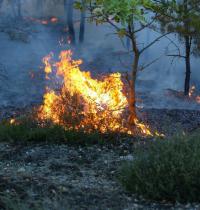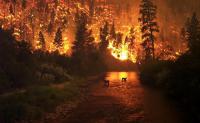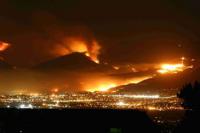-
Wildfire map shows European countries most at risk of catastrophic fire damage

Cities and tourist areas such as Catalonia, Madrid, and Valencia are among those most at risk of catastrophic damage from wildfires in Europe, according to research. An international research team has put together a map using satellite data that details the countries in Europe with the highest likelihood of experiencing wildfire damage — with large fires occurring more frequently near “Wildland-Urban Interface” WUI areas in the countries of Albania, Bulgaria, Cyprus, France, Italy, and Spain.
-
-
Protecting firefighters from harm
If there is anything common among the 1.1 million firefighters — both career and volunteer — serving in the United States, it is that at any moment, they may be required to put their lives on the line to protect people and property from disaster. But who helps protect these dedicated public servants from the on-the-job dangers they face?
-
-
Modern buildings have an alarming flaw when people need to escape quickly
The landscapes in which many of us live would have been unimaginable to previous generations. We now have skyscrapers so striking and tall they would make Icarus turn pale. Yet in emergency situations, our seemingly brilliant designs sometimes turn against us – and become death traps when disaster strikes. There is a major problem with the way we evaluate the safety of the structures in which we live and work. Until we address it, our chances of survival are a little like those of the characters from Greek legend – in the lap of the gods.
-
-
Science-based data collection key to better wildland fire defense
In February 2011, three fires raged through suburban areas outside of Amarillo, Texas, at the wildland urban interface (WUI), the area where residential communities and undeveloped wildlands meet. A new report by the National Institute of Standards and Technology (NIST) describes how researchers analyzed a major 2011 Texas wildland fire using a rigorous and scientifically based post-fire data collection approach, a system they believe will lead to improved defensive measures and strategies for significantly reducing structural damage and property loss.
-
-
U.S. must address the “wicked problem” of wildfire

U.S. wildfires burned more than 10.1 million acres in 2015 — a new record. Wildfire suppression costs the United States, on average, $2.9 billion a year. Researchers say that the United States must make preparing for and adapting to wildfire a top national priority, recognizing that widfire is a “wicked problem” — one so complex that a one-size-fits-all solution does not exist.
-
-
Paramedics' risk of being assaulted far exceeds risk to firefighting colleagues
Research found that y medical technicians and paramedics are fourteen times more likely to be violently injured on the job than the firefighters they work alongside. The researchers found that assault-related injuries are often not reported, not acknowledged by administration, and therefore they are internalized by the workers as a “part of the job.”
-
-
Paramedics' risk of being assaulted far exceeds risk to firefighting colleagues

Research found that y medical technicians and paramedics are fourteen times more likely to be violently injured on the job than the firefighters they work alongside. The researchers found that assault-related injuries are often not reported, not acknowledged by administration, and therefore they are internalized by the workers as a “part of the job.”
-
-
A firefighter drone flies, crawls up walls
The 1974 American disaster film “Towering Inferno” depicted well the earnest struggles of firefighters engaged in ending a fire at a 138-story skyscraper. To this day, fires at high-rise buildings are considered one of the most dangerous disasters. Researchers developed a wall-climbing scout drone to fight fires in high-rises, finding the source of the fires and locating people trapped inside.
-
-
New sensors detect cable fire before it starts burning
Fires are frequently caused by smoldering cables. New sensors now help detect such smoldering fires at an early stage by analyzing the plastic vapors released by overheated insulating cables. Scientists have developed these hybrid sensors that combine measurement processes with data evaluation. These detect the gases released from the plastic coating due to heating and reliably identify and analyze the gas mixture and its concentration.
-
-
Actions can change outcomes of wildfires in wildland urban interface (WUI)

The ten years since 2002 saw an annual average of nearly 71,000 wildland urban interface (WUI) fires recorded and 1.9 million hectares (4.7 million acres) burned. Today, more than 32 percent of U.S. housing units and one-tenth of all land with housing are situated in the nation’s 89 million hectares (220 million acres) of WUI, putting approximately 72,000 communities and more than 120 million people at risk. A new study demonstrates that prompt and effective action can significantly change the outcome of fires that occur in WUI — areas where residential communities and undeveloped wildlands meet.
-
-
Fighting fire with research results
Every year, devastating forest fires take place in Europe and around the world, destroying thousands of hectares of forests and severely impacting citizens and the environment. EU-funded research teams, mindful of the current and future risks, have been focusing their efforts on developing systems and tools that can help avert disaster.
-
-
Online residential fire simulation tool for training firefighters
Firefighting is not what it used to be. Whether it is a complex blaze raging in an urban high-rise or a seemingly straightforward single-level home fire, modern building construction and furnishings have made fighting fires more difficult: Flames burn hotter, produce more smoke, and spread more quickly. But fire research has advanced, too, and researchers are working with five major urban fire departments to build new knowledge on modern residential firefighting into game-based online simulations with an engaging, dynamic format.
-
-
New flame retardant is naturally derived, nontoxic
Flame retardants are added to foams found in mattresses, sofas, car upholstery, and many other consumer products. Once incorporated into foam, these chemicals can migrate out of the products over time, releasing toxic substances into the air and environment. Inspired by a naturally occurring material found in marine mussels, researchers have created a new flame retardant to replace commercial additives that are often toxic and can accumulate over time in the environment and living animals, including humans.
-
-
DHS recruits Silicon Valley entrepreneurs to develop first-response technology
DHS wants better technology for first responders — police, firefighters, and EMTs — but rather than pushing for innovation from within the massive corporations that already provide technology to government agencies, the DHS has come to Silicon Valley to tap the entrepreneurial ecosystem of northern California. Giant technology firms have resources of large scale manufacturing and distribution, but there is one crucial difference. Technology startups are much more nimble, and can shift their development much faster than the huge corporations can.
-
-
Seeing through the dark clearly

A new device, dubbed Thermal on Demand (TOD), allows firefighters to see everything in a heavily smoke-filled room, where the unassisted eye sees nothing but a pitch-black environment. TOD allows responders to see doors, furniture, light switches, debris on the floor, and victims lying on the floor. Looking through a periscopic lens, in front of a thermal camera, the wearer sees a detailed image of everything in the immediate vicinity.
-
- All
- Regional
- Water
- Biometrics
- Borders/Immig
- Business
- Cybersecurity
- Detection
- Disasters
- Government
- Infrastructure
- International
- Public health
- Public Safety
- Communication interoperabillity
- Emergency services
- Emergency medical services
- Fire
- First response
- IEDs
- Law Enforcement
- Law Enforcement Technology
- Military technology
- Nonlethal weapons
- Nuclear weapons
- Personal protection equipment
- Police
- Notification /alert systems
- Situational awareness
- Weapons systems
- Sci-Tech
- Sector Reports
- Surveillance
- Transportation
Advertising & Marketing: advertise@newswirepubs.com
Editorial: editor@newswirepubs.com
General: info@newswirepubs.com
2010-2011 © News Wire Publications, LLC News Wire Publications, LLC
220 Old Country Road | Suite 200 | Mineola | New York | 11501
Permissions and Policies
Editorial: editor@newswirepubs.com
General: info@newswirepubs.com
2010-2011 © News Wire Publications, LLC News Wire Publications, LLC
220 Old Country Road | Suite 200 | Mineola | New York | 11501
Permissions and Policies
